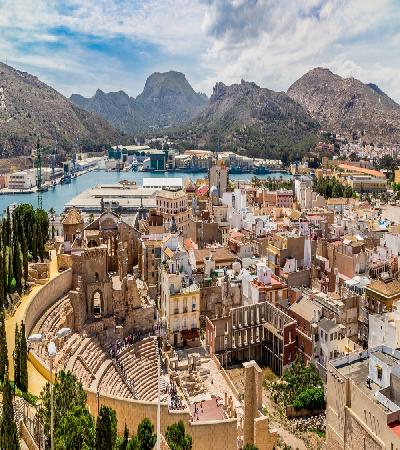 Murcia is located at a distance from the Mediterranean Sea, in what is known as Huerte, a fertile plain crossed by several rivers and irrigation channels. The city is located on the banks of the Segura river; the historic center is on the left, on the north side. Murcia is a large city in the southeast of Spain and the administrative center of the region of the same name. It is located on the banks of the Segura River, 25 km from the Mediterranean Sea. Murcia - a kind of compromise between a bustling metropolis and the province, a university city with a rich history, characterized by calm and restraint. Murcia and the entire region is famous throughout Spain for its good food and the friendliness of the locals, excellent sandy beaches and natural landscapes. It is one of the largest agricultural provinces in the country, whose fruits and vegetables are exported to other European countries. The historic center covers an area of 3 km2.
Murcia is located at a distance from the Mediterranean Sea, in what is known as Huerte, a fertile plain crossed by several rivers and irrigation channels. The city is located on the banks of the Segura river; the historic center is on the left, on the north side. Murcia is a large city in the southeast of Spain and the administrative center of the region of the same name. It is located on the banks of the Segura River, 25 km from the Mediterranean Sea. Murcia - a kind of compromise between a bustling metropolis and the province, a university city with a rich history, characterized by calm and restraint. Murcia and the entire region is famous throughout Spain for its good food and the friendliness of the locals, excellent sandy beaches and natural landscapes. It is one of the largest agricultural provinces in the country, whose fruits and vegetables are exported to other European countries. The historic center covers an area of 3 km2.
The city was founded by Muslims in 825, in the 13th century it had become a prosperous and great settlement, the products of local artisans were valued far beyond its borders. Silk and ceramics were exported throughout Europe. Little by little the inhabitants of the city adopted Christianity, in this soil of Murcia the conflicts began, which lasted from 1243 to 1266.
Episcopal Palace in Murcia:
It is impossible not to notice it thanks to its very original facade. Its appearance corresponds to the rich interior decoration, part of which is made in the style of the Roman Baroque. The Cathedral of Santa María in Murcia - has been rebuilt, completed and expanded many times, so that the attentive visitor will see the building, parts of which are made in the Gothic, Baroque, Renaissance and Neoclassical style. The evolution of architectural preferences in Europe can be studied with this building.
The Roman Theater of Cartagena:
It was discovered only in the late 1980s and is considered the largest. About 10 years ago, its destroyed parts were restored.
Murcia Cathedral:
Probably Murcia's most famous landmark, this grand structure is known as a Baroque treasure, but it actually features a mix of architectural styles used during the three centuries it took to build. The main facade facing the Plaza del Cardenal Belluga is impressive, with surprising columns and sculptures. Inside, explore the lavishly decorated chapels and discover the tomb of King Alfonso X. There is also the 93-meter-high bell tower, the second tallest in Spain.
Real Casino de Murcia:
Another famous landmark of the city, this is actually a luxurious private gentlemen's club frequented by those who like to see and be seen. Built by and for the wealthy elite of the city, it remains a private club today. However, you can join a tour to see the opulent interior, with a frescoed ballroom and a large patio modeled on the palaces of Andalusia.
Floridablanca Gardens:
During Murcia's scorching summers, residents of the city head to this cool oasis across the river. It has colorful flower gardens and many shady areas, and its most impressive inhabitants are the old ficus trees. This is the oldest public park in the city, open since the mid-19th century, and one of the first of its kind in Spain.
Murcia Archaeological Museum:
A lesser-known place for tourists in Murcia, this museum is a delight for those interested in all things historical. You will see artifacts from the Roman and Moorish heritage of the city and beyond the Bronze and Iron Age. In addition, there are many more treasures to discover in the entire region of Murcia, which houses no less than 2,000 archaeological sites.
Costa Cálida and Costa Blanca:
Take the short trip to the Mediterranean and sunbathe on these famous and sunny Spanish coasts. The southern part of the Costa Blanca is dotted with quiet beach towns, and there are stunning blue flag beaches waiting for you at Torre de la Horadada. It is only 50 kilometers away by car, so you can sunbathe within an hour of leaving the city.
Mar Menor:
One of the natural attractions of the coast is the Mar Menor, the largest saltwater lake in Europe. Just like the Mar Menor, the Mediterranean Sea itself is consequently called the "greater sea". Near the lake is the old fishing village of Cabo de Palos, and the untapped beaches of the Calblanque National Park.
